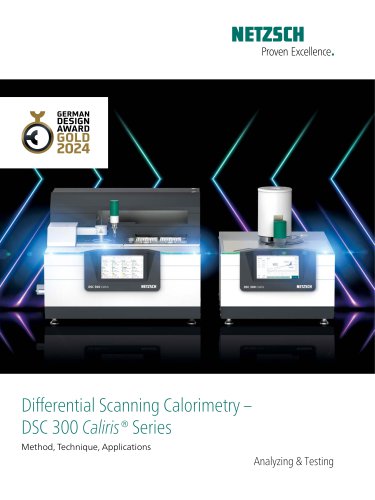 Website:
NETZSCH Analyzing & Testing
Website:
NETZSCH Analyzing & Testing
Group: NETZSCH
Catalog excerpts

Advanced Hydrogen Research BY MEANS OF THERMAL ANALYSIS Thermal Analysis and Hydrogen Hydrogen Fuel for Tomorrow Hydrogen (H2) is considered the energy carrier of the future. It is a versatile and clean energy source that can be produced from a variety of sources, including renewable energy sources such as wind and solar. H2 is also being used to reduce high CO₂ emissions from metallurgy processes by the direct reduction of such substances as iron ore. While hydrogen production, storage, and conversion have reached a certain technological level, there is still room for improvement and new discoveries. Thermal Analysis can help us better understand material interactions. Challenges in Hydrogen Usage Hydrogen presents a significant flammability risk, demanding special safety precautions during its production, handling, and utilization. Even low concentrations of hydrogen need to be taken seriously, as ignition can occur when concentrations are only 4% hydrogen in air at room temperature. NETZSCH offers the ability to measure materials in a hydrogen atmosphere along with an accompanying safety concept. Measurements can be conducted in a 100% H₂ atmosphere or mixed with other nonflammable gases like nitrogen (N2) or argon (Ar). Inert gas is also used to purge the thermobalance. If a failure occurs, the device is flushed with inert gas. Conduct Reduction and Oxidation Experiments in a Safe Environment Reduction is used in a variety of industrial processes. Examples include metallurgical processes and the storage and release of H₂ in certain materials. To conduct reduction or oxidation experiments, any STA 449 can be upgraded for use with hydrogen gas. Along with the reduction test, NETZSCH offers the oxidation test under air atmosphere. The STA has to be purged with inert gas in an intermediate state until safe conditions for a gas change are reached. NETZSCH offers the STA 449 hydrogen system as complete solution including the newly developed H₂Secure control
Open the catalog to page 1
H₂Secure Concept Defined H₂ Gas Volume Hydrogen enters at the top of the furnace. H₂ is confined to a defined space above the continuously purged balance chamber. The central communication box receives gas concentration information and allows or denies gas flow based on set limits. Fail-Safe Security In the case of a power failure, magnetic valves open up and release inert gas, which removes hydrogen from the system. H₂ and O₂ gas concentrations are continuously measured to ensure safe handling. Hydrogen Gas Supply Hydrogen can be supplied from an H₂ generator or H₂ cylinder and is...
Open the catalog to page 2
The Reversible Nature of Copper (Cu) – Copper Oxide (CuO) Redox Reaction 100 The example illustrates a cycle experiment exploring the reversible reaction of CuO with hydrogen and air by monitoring the mass changes throughout the process. Initially, CuO undergoes reduction in an H2 atmosphere, leading to the formation of metallic Cu. Subsequently, in an oxidizing environment, metallic Cu oxidizes again to CuO with the introduction of air. In the following cycles, an increasing loss in the oxidation potential can be observed, indicating degradation of the catalytic capability. With the help...
Open the catalog to page 3
Technical Specifications STA 449 + H₂Secure Box Temperature range Sensor types* Thermocouple types* Sensor type for reduction experiments only Optional 4-fold MFC Hydrogen supply W Possible switching between hydrogen and air atmospheres in one measurement Supplied by the operator, e.g., hydrogen generator, H₂ cylinder Optional gas outlet treatment Upgrade of existing STA 449 * Possibility of reduced life time depending on experimental parameters NGB · Advanced Hydrogen Research by means of Thermal Analysis · EN · 0624 · Technical specifications are subject to change.
Open the catalog to page 4All NETZSCH Analyzing & Testing catalogs and technical brochures
-
DSC 300 Caliris Series
28 Pages
-
STA 509 Jupiter Series
28 Pages
-
TG 309 Libra Series
24 Pages
-
DEA 288 Ionic
20 Pages
-
STA 2500 Regulus
12 Pages
-
NTA Guarded Hot Plate Series
16 Pages
-
TMA 402 F1/F3 Hyperion®
16 Pages
-
Rosand Series
20 Pages
-
Accelerating Rate Calorimetry
20 Pages
-
LFA 467 HyperFlash® Series
28 Pages
-
DMA 303 Eplexor
24 Pages
-
NTA HotBoxes
16 Pages
-
DIL 402 Expedis Select/Supreme
28 Pages
-
DIL 402 Expedis Classic
16 Pages
-
Product Overview
12 Pages
-
NETZSCH Energy Solutions
40 Pages
-
Advanced Materials Testing
32 Pages
-
NTA Fire Testing Systems
20 Pages
-
Kinetics NEO
20 Pages
-
TG-FTIR - product brochure
24 Pages
-
TA-QMS Coupling
28 Pages
-
Kinexus Prime DSR Series
20 Pages
-
Kinexus Prime Series
20 Pages
-
HMOR 422
1 Pages
-
RUL/CIC 421
1 Pages
-
Cone Calorimeter TCC 918
12 Pages
-
Thermal Insulation Materials
24 Pages
-
SBA 458 Nemesis®
24 Pages
-
NETZSCH NEVIO Instrument Series
24 Pages
-
LFA 427 - product brochure
24 Pages
-
DMA GABO EPLEXOR up to 1500°C
12 Pages
-
GABOMETER®
8 Pages


























































